
eFatigue gives you everything you need to perform state-of-the-art fatigue analysis over the web. Click here to learn more about eFatigue.
Probabilistic BS 7608 Welds Technical Background
Go to the BS 7608 Welds Technical Background section for a more complete description of the fatigue variables.
For purposes of evaluating fatigue, weld joints are divided into several classes. The classification of a weld joint depends on:
- the macroscopic geometry of the pieces welded,
- the direction of the cyclic stresses, and
- the location of the crack that leads to failure.
Two fillet welds are shown below. One is loaded parallel to the weld toe (Class D) and the other is loaded perpendicular to the weld toe (Class F2).
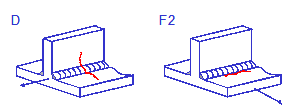
It is then assumed that any complex weld geometry can be described by one of the standard classifications. Fatigue lives are computed from the applied stress ranges, ΔS, and the slope, m, and intercept, Co, of standard weld joint SN curve.
Loading Variability
Mean stress effects are already included in the basic SN data and no correction for external mean stresses is needed for a welded joint so that only the stress range is needed.
What is a reasonable variability for the loading variables? Naturally, every situation is different, but based on past experience we can provide some general guidance. The relationship between standard deviation and COV for a LogNormal distribution is given below. Three standard deviations represents most (99.7%) of the data. Most of the data is within �16% of the median for a COV of 0.05 and within a factor of �2 for a COV of 0.25.
|
COVx |
Standard Deviation, Inx |
||
|
1 68.3% |
2 95.4% |
3 99.7% |
|
|
0.05 0.1 0.25 0.5 1 |
1.05 1.10 1.28 1.60 2.30 |
1.11 1.23 1.66 2.64 5.53 |
1.16 1.33 2.04 3.92 11.1 |
When comparing loading histories for determining the variability it is convenient to define an equivalent constant amplitude load from a variable amplitude history. That is, what constant amplitude load would produce the same fatigue life as the original loading history? The equivalent load, Feq for 106 constant amplitude cycles can be computed from the loading history as

where m is the slope of the SN curve. Typically this should be 4-6 for notched components. Two sets of data are plotted in the figure below. One set of data comes from test track driving of a motor home, the other comes from driving an auto in various cities during normal operation.

Here we are interested in the COV for the two sets of data. The test track data has a COV of 0.12 which is typical of controlled processes. Unsupervised city driving has much more variability with a COV of 0.3.
Selecting an appropriate variability will depend on how well controlled the loading will be. Many customers with widely varying usage characteristics will have a high variability.
Weld Classifications
One of the most comprehensive sources for designing welded structures is British Standard BS 7608 "Code of practice for Fatigue design and assessment of steel structures". It provides standard SN curves for welds.
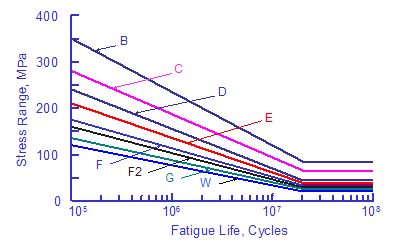
The curves shown above are valid for structural steel welds. Fatigue lives are not dependant on either the material or the applied mean stress. Welds are known to contain small cracks from the welding process. As a result, the majority of the fatigue life is spend in growing these small cracks. Fatigue lives are not dependant on material because all structural steels have about the same crack growth rate.
The Weld Classifications Finder may be used to select a weld class of the properties of the weld joint may be entered. The weld classification finder contains the statistical distribution for the constant C. A fatigue limit, NFL, of 107 is used for welds. The fatigue limit will have the same distribution as C with a correlation coefficient of 1. This results in a series of parallel SN curves.

You may enter a distribution for the slope m although this is not recommended because of the high degree of correlation between the constants C and m and SFL. When a distribution is selected for the slope, the fatigue limit entered is ignored and a consistent set of fatigue properties is computed from the slope. This is not recommended because it will introduce additional variability.

When the distributions for the intercept and fatigue limit are different, the slope entered is ignored and a new slope is computed to have a consistent set of fatigue properties.

The Simulation
Typically, 100 trials are used in the simulation, resulting in 100 calculated fatigue lives. When the equivalent stress is less than the fatigue limit, the life is set equal to the fatigue limit cycles. The number of lives less than the fatigue limit cycles is probability of failure. If the probability of failure is less than 5%, the number of simulations is increased to 1,000 to obtain a more accurate number.
Output Results
Results of the simulation are given in graphical and tabular formats. First the median life from the simulation is given. If the fatigue lives in the simulation are finite, a cumulative distribution of the calculated lives is presented in a LogNormal format. This chart is useful for determining probabilities of failure for other lives. Numerical values for this plot are available as the log of the life and number of standard deviations.
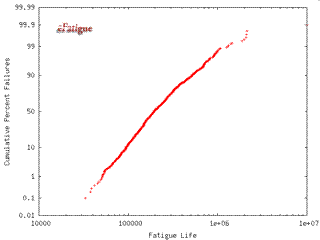
A probabilistic sensitivity analysis is performed to determine which variables have the highest contribution to the variability in fatigue lives. The probabilistic sensitivity factor ai is defined as

The first term ∂Nf / ∂Xi(X) is the influence of the variable Xi on the fatigue life. This determines the most important variables affecting the fatigue life. It is multiplied by the standard deviation σi. A variable that may have a large influence on the fatigue life may have very little variability so that it will not contribute to the variability in fatigue lives. The elastic modulus is an example of such a variable. Results are plotted in a pie chart.
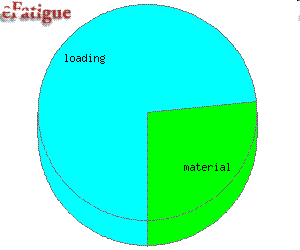
A table of results from the simulation is also given. The input data is displayed first. All calculated variables are also given.

Finally a table of the input data is also given.
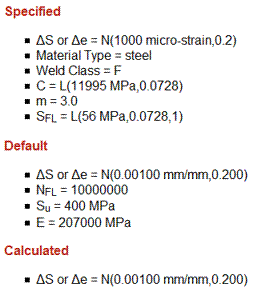
 日本語
日本語